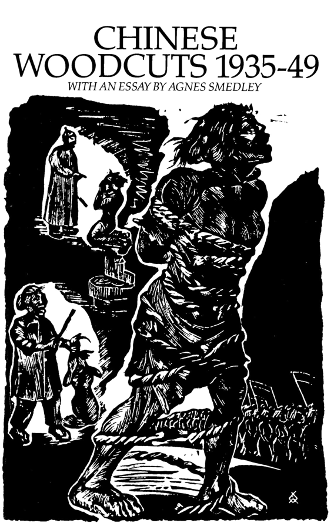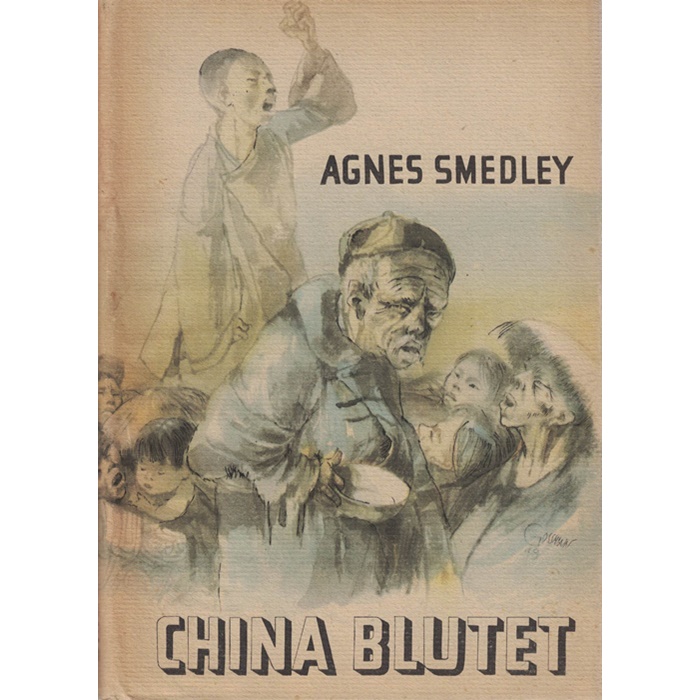Archive
Agnes Smedley
- Agnes
- Smedley
Rusty Knails
- 23-02-1892
- Missouri (US)
- 06-05-1950
- Oxford (GB)
- WriterJournalist
Agnes Smedley was an American journalist, writer and activist. Between 1929 and 1941, she lived in China, where she wrote reportages for European and American newspapers. As a feminist and socialist writer, she focused on the concerns of rural people and paid special attention to artists and their work during the Chinese revolution.
Word Count: 51

Smedley, Agnes. “Chinese Woodcuts 1935–49.” The Massachusetts Review, vol. 25, no. 4, 1984, pp. 553-564. 
Aino Taylor, Agnes Smedley in Kuomintang uniform as worn by Communist troops in central China during the United Front in 1939, Agnes Smedley Collection (© University Archives, Arizona State University Library). 
Smedley, Agnes. China blutet. Cover, Dietz Verlag Berlin, 1949. The German exiled artist John Heartfield (née Helmut Herzfeld) did a letterpress print for Cina blutet for his brother’s publishing house Malik Verlag during their exile in Prague in 1936. The print is archived at the Museum of Modern Art in New York and belongs to the Jan Tschichold Collection. Jan Tschichold was a calligrapher, typographer, and book designer. In 1933 he fled with his family to Switzerland and stayed for longer periods in London and Hampstead where he was involved in the design of the Penguin Books. 72 Route Grouchy, French Concession (now 52 Yanqing Lu, Xuhui Qu); Normandie Apartments, Avenue Joffre, French Concession (1850 Huaihai Lu Zhong Duan, Huangpu Qu); Le Bearn Apartments, 449–479 Avenue Joffre, French Concession (Huaihai Lu Zhong Duan, Huangpu Qu)/ 96 Rue Marcel Tillot, French Concession (Xing’an Lu, Huangpu Qu), Shanghai
- Shanghai
- Mareike Hetschold. "Agnes Smedley." METROMOD Archive, 2021, https://archive.metromod.net/viewer.p/69/2952/object/5138-8103264, last modified: 15-09-2021.
-
Richard PaulickArchitectDesignerShanghai
After studying with Hans Poelzig, Richard Paulick worked in Walter Gropius’s office and frequented the Bauhaus in Dessau before emigrating to Shanghai in 1933. After his return, he became an influential planner and architect in the GDR, from 1950 until his retirement
Word Count: 41
Voice of ChinaMagazineShanghaiSong Qingling, widow of the founder of the republic, Sun Yatsen, supported the political magazine Voice of China in 1936, which appeared in Shanghai in English. After the Japanese army invaded China in August 1937, the magazine had to cease publication.
Word Count: 39
Exhibition of prints by Käthe KollwitzExhibitionShanghaiA German woodcut exhibition organised at the Zeitgeist Bookstore presumably took place in June 1931. In June 1932. A further exhibition with more than 200 works by German artists, including works by Käthe Kollwitz and George Grosz, was shown at the Chinese Y.M.C.A.
Word Count: 44